[TL;DR] Summary: For decor enthusiasts, finding the best stud finder isn’t optional—it’s essential. These devices prevent costly wall damage, protect expensive artwork, and ensure your design vision comes to life safely. From gallery walls to floating shelves, a quality stud finder transforms decoration from risky guesswork into confident installation.
Introduction: The Hidden Truth Behind Every Perfect Gallery Wall
The best stud finder might just be the most underrated tool in your home decor industry. You’ve spent hours curating that perfect oversized mirror. You’ve measured, remeasured, and visualized exactly where your statement piece will transform your living room. Then, mid-installation, your beautiful artwork crashes to the floor because you missed the stud by three inches.

Sound familiar? You’re not alone. Here’s what the home improvement industry doesn’t want you to know: ceiling and wall projects caused over 306,000 emergency room visits in a single year. But the real pain isn’t just physical—it’s watching your investment shatter because you relied on the “knock and guess” method instead of using proper stud detection technology.
Whether you’re hanging a farmhouse-style floating shelf, mounting your cherished vintage mirror collection, or creating that Pinterest-worthy wall of woven baskets, this guide reveals exactly why a stud finder is non-negotiable for anyone who takes their home decor seriously. By the end, you’ll understand which features matter, which products deliver, and how to protect both your walls and your wallet.
I. The Costly Reality: Why Decor Lovers Can’t Afford to Skip This Tool
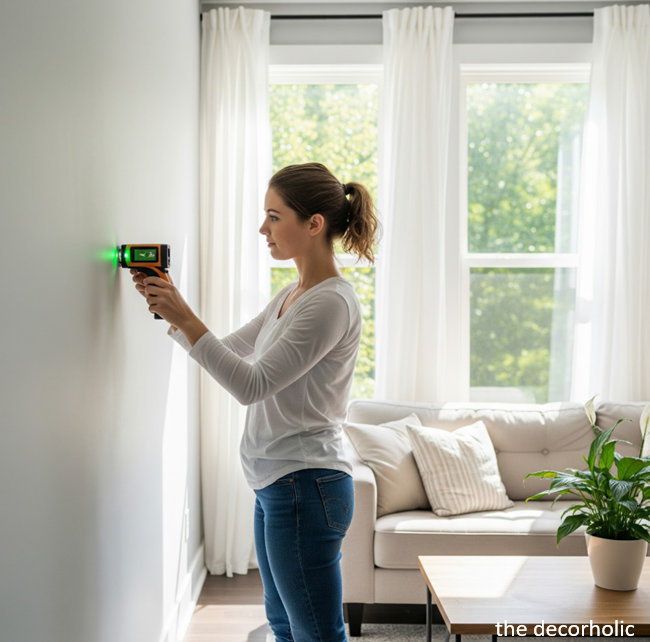
A quality stud finder prevents the three most expensive mistakes home decorators make: missing studs entirely, drilling into hidden pipes or wires, and creating irreparable wall damage that ruins your design aesthetic. These aren’t minor inconveniences—they’re budget-destroying disasters that turn your decorating dreams into renovation nightmares.
Consider this sobering reality: just one inch of water from a punctured pipe can cause up to $25,000 in damage to your home. That gallery wall you’re planning? If you drill into a water line without detection, you’ve just turned an afternoon project into a financial catastrophe. The repair costs, insurance deductibles, and lost decor pieces add up faster than you can say “why didn’t I use a stud finder?”
But the hidden cost goes deeper than broken pipes. When that heavy wooden shelf crashes down at 2 AM because it wasn’t properly anchored to a stud, you’re not just losing the shelf—you’re losing the handcrafted pottery displayed on it, the wall paint beneath it, and possibly even the underlying drywall structure. Professional repair for moderate wall damage typically runs between $300-$800, not including the cost of replacing your destroyed decor pieces.
Why A Stud Finder is a Must-Have
Here’s the truth that separates amateur decorators from design-savvy homeowners: the invisible infrastructure behind your walls determines whether your design vision succeeds or fails. Studs—those wooden or metal beams hidden behind your drywall—are the only truly secure anchor points for anything heavier than a small picture frame. Miss them, and you’re essentially gambling with gravity.
The emotional toll is equally devastating. Imagine spending weeks sourcing the perfect vintage brass sconces for your entryway, only to watch them pull free from the wall during your housewarming party. Or picture your child’s room, where that adorable floating bookshelf you painstakingly styled now has a gaping hole beneath it because the drywall anchors failed under the weight of their book collection.
Pro Tip: Before you hang anything over 10 pounds, ask yourself this question: “Am I willing to pay $500+ to fix this wall when it fails?” If the answer is no, invest the $30-60 in a reliable stud finder today.
You’ll Also Like: 7 Mistakes To Avoid For A Clutter-Free Living Room
II. The 5 Non-Negotiables: What Every Decor-Focused Stud Finder Must Have

The best stud finder for home decorators must detect wood and metal studs, identify live electrical wiring, offer multi-sensor accuracy, provide clear visual feedback, and include depth-scanning capabilities—ensuring every mounting decision protects both your decor and your walls.
According to testing by industry experts, traditional single-sensor stud finders miss up to 30% of studs in older homes with irregular framing patterns. For someone creating a curated wall display, that margin of error is unacceptable. Modern multi-sensor technology, like the systems found in Franklin Sensors’ ProSensor line, uses 13 sensors simultaneously to map your entire wall structure in real-time.
1. Multi-Sensor Technology: Because Your Walls Aren’t Perfect
Your home’s framing wasn’t built with your Pinterest board in mind. Studs near doorways often sit mere inches apart. Corner studs twist at odd angles. Previous homeowners may have added blocking or cross-bracing that creates false readings on basic stud finders.
Multi-sensor stud finders solve this by illuminating the entire stud profile at once. Instead of marking a single edge and hoping you calculated the center correctly, you see exactly where the stud begins, where it ends, and where the optimal mounting point lies. For asymmetrical decor arrangements or precisely spaced shelf systems, this accuracy is transformative.
2. Live Wire Detection: Your Safety Net Against Electrocution
Behind those pristine walls lies a network of electrical wiring powering your outlets, switches, and light fixtures. Standard magnetic stud finders can’t detect these wires—they only respond to metal fasteners. When you drill into a live wire without warning, you’re risking serious injury, potential fire hazards, and electrical system damage that requires licensed electrician intervention.
The best stud finders, including models from Bosch and Zircon, incorporate AC detection that alerts you to electrical current before your drill bit makes contact. For decor enthusiasts who frequently rearrange wall elements or add new lighting features, this feature literally saves lives.
3. Deep Scanning Capability: For Plaster, Tile, and Thick Walls
Not every home has standard half-inch drywall. Older homes often feature thick plaster-and-lath construction. Bathroom and kitchen accent walls use tile backerboard that adds substantial depth. Some modern homes incorporate sound-dampening insulation that increases wall thickness.
Basic stud finders penetrate only 0.75 inches—useless for anything beyond the thinnest drywall. Professional-grade models offer scanning depths of 1.5 to 2 inches, ensuring reliable detection regardless of your wall composition. When you’re mounting a statement mirror in your renovated bathroom or hanging floating shelves in your historic craftsman home, scanning depth directly determines success or failure.
4. Pipe and Metal Detection: Protecting Against Water Damage
Your walls contain more than just studs and wires. Plumbing runs through wall cavities to supply bathrooms, kitchens, and laundry areas. HVAC ducts snake behind drywall. Previous mounting projects left metal brackets and hardware embedded in your walls.
Advanced stud finders differentiate between these materials. Metal detection mode locates pipes, ducts, and fasteners. Some premium models even distinguish between ferrous (magnetic) and non-ferrous metals. When you’re planning that dramatic floor-to-ceiling shelving unit in your dining room, knowing exactly what’s behind every potential drilling location prevents disasters that transform decor projects into plumbing emergencies.
5. Visual Feedback Systems: Clear Answers for Confident Mounting
Ambiguous beeping doesn’t cut it when you’re positioning a $400 handwoven wall hanging. The best stud finders use LED light arrays, LCD screens, or smartphone displays that provide unmistakable visual confirmation. Franklin Sensors’ models illuminate a series of lights directly over the stud location. Bosch’s GMS120 displays material type, depth, and center-finding markers on a backlit LCD screen.
For decorators who work with precise spacing—think evenly distributed shelf brackets or symmetrical artwork groupings—this visual clarity eliminates the guesswork that leads to unsightly extra drill holes and patching compounds.
Pro Tip: Look for models with auto-calibration. Traditional stud finders require calibration on a stud-free section of wall before each use—a tedious process that frequently produces false readings if done incorrectly. Auto-calibrating models start scanning immediately, saving time and frustration during multi-item installations.
You’ll Also Like: 10 Hottest Bedroom Trends to Try Now
III. Expert Insights: What Professional Decorators Know (And DIYers Don’t)
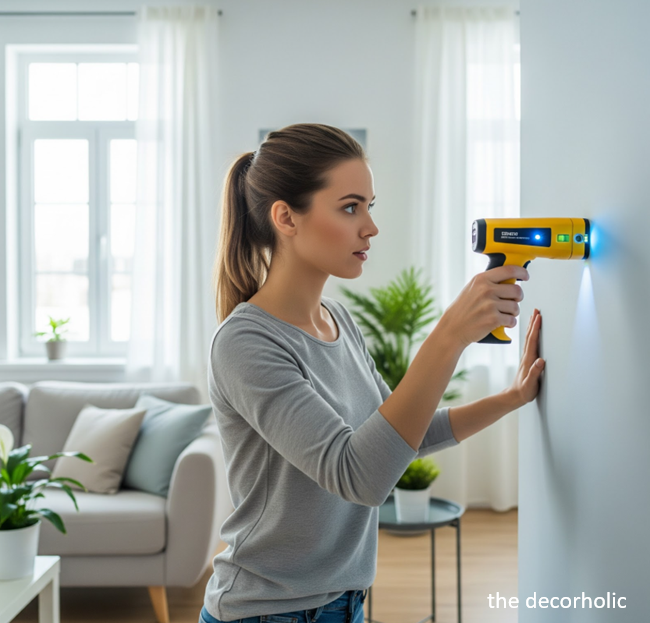
According to carpenter Alex Rennie, who spent years mounting large-scale installations in residential and commercial spaces, “Locating studs accurately was essential” when installing wall shelving, televisions, and corporate conference room monitors. Professional installers don’t guess—they verify. The difference between amateur and professional results often comes down to tools, not talent.
Industry testing reveals another crucial insight: stud finder reliability varies dramatically by wall type. Research published by Bob Vila’s testing team shows that electromagnetic stud finders perform inconsistently on plaster walls, where the varied composition confuses density-based detection systems. For homes built before 1950, magnetic stud finders or premium electronic models specifically rated for plaster become essential.
Consider this data point from the National Safety Council: DIY ceiling and wall projects account for an injury rate of 92.90 per 100,000 people, resulting in over 306,000 hospital visits annually. Many of these injuries stem from falling objects—shelves, mirrors, artwork—that weren’t properly anchored to structural supports. The right stud finder doesn’t just improve your decor execution; it prevents genuine safety hazards.
Pro Tip: Professional decorators mark both stud edges, not just the center. This technique, made possible by multi-sensor or edge-detecting stud finders, ensures your mounting hardware actually engages the stud instead of catching just the edge where wood density decreases. For heavy items like solid wood shelving or large metal wall art, this edge-to-edge verification provides the structural confidence professionals rely on.
You’ll Like This Trending Post: 10 Easy Ways For a Bedroom Refresh on a Budget
IV. 🔥 7 Best Stud Finders on Amazon for Your Home Decor Projects
For decor lovers who demand reliability, accuracy, and safety, the following stud finders represent the market’s top performers across different price points and use cases—each selected for features that directly impact successful wall installations.
Every product below has been selected specifically for homeowners who care about aesthetics as much as functionality. These aren’t contractor-grade tools that sacrifice user-friendliness for industrial specifications. They’re intuitive, reliable devices that integrate seamlessly into residential decorating workflows.
1. Franklin Sensors ProSensor M210 – Best for Gallery Walls and Precise Spacing

Franklin Sensors ProSensor M210
Features 13 precision sensors and 21 LED display that shows the full width of studs instantly—no calibration needed. Perfect for creating perfectly spaced gallery walls and shelf systems. Includes live wire detection and built-in bubble level for complete safety and accuracy.
Check Price on Amazon →4.6 Stars out of 4,697 Reviews. 9K+ bought in the past month
When you’re creating that museum-quality gallery wall or installing perfectly aligned floating shelves, the ProSensor M210 eliminates the guesswork that ruins symmetry. Its 13-sensor array shows you the complete stud width in a single pass—no more marking one edge, measuring over, and hoping you calculated correctly. The built-in LED lights illuminate both stud edges and center simultaneously, ensuring your mounting hardware engages solid wood instead of catching just the stud’s edge.
For decor enthusiasts who constantly rearrange or add pieces, this tool’s instant-on technology means no tedious calibration before each use. Place it anywhere on the wall, press the button, and scan. The auto-off feature preserves battery life between projects, while the included ruler and bubble level eliminate the need for separate tools when marking drilling locations.
Shop Franklin Sensors ProSensor M210 on Amazon
Why decor lovers choose this: The wide scanning bed detects multiple studs simultaneously—perfect for planning complex wall arrangements without constantly rescanning. If you’re the type who sketches wall layouts before drilling a single hole, this tool transforms planning into confident execution.
2. Bosch GMS120-27 Wall Scanner – Best All-Around for Design-Conscious Homeowners
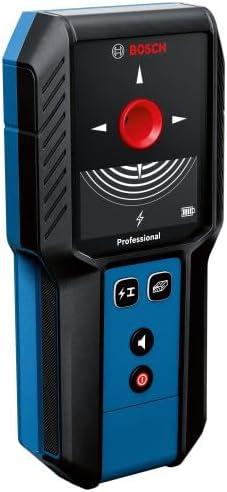
Bosch GMS120 Wall Scanner
Multi-detection scanner that finds wood studs, metal, and live wiring with exceptional accuracy. Backlit LCD screen shows detection mode, depth, and center-finding indicators. Deep-scanning capability (up to 4.75″ for metal) works through plaster, tile, and thick drywall.
Check Price on Amazon →4.1 Stars out of 4,467 Reviews. 400+ bought in the past month
The Bosch GMS120 doesn’t just find studs—it maps everything behind your walls. Its multi-detection modes identify wood studs, metal components, and live electrical wiring, giving you a complete infrastructure picture before you commit to drilling. The backlit LCD screen displays detection mode, target depth, and center-finding indicators with visual clarity that eliminates interpretation errors.
For homeowners decorating rooms with mixed wall types, the GMS120’s deep-scanning capability (up to 4.75 inches for metal) penetrates plaster, tile backerboard, and thick drywall that stymie basic finders. The signal strength indicator shows exactly how deep your detected object sits, helping you select appropriate screw lengths for secure mounting without over-penetrating into plumbing or wiring.
Shop Bosch GMS120 Wall Scanner on Amazon
Why decor lovers choose this: The metal detection prevents the nightmare scenario where you drill into a pipe behind your feature wall. One testing reviewer noted it achieved “near-perfect scores in all rating metrics,” making it the gold standard when failure isn’t an option.
3. Franklin Sensors ProSensor 710+ – Best for Heavy Artwork and Large Mirrors

Franklin Sensors ProSensor 710+
Professional-grade 13-sensor technology with integrated bubble level—perfect for mounting large mirrors and heavy artwork. Ultra-durable construction survives drops that destroy lesser models. Wide 7.5″ scanning width detects double-stud configurations near corners.
Check Price on Amazon →4.6 Stars out of 10,845 Reviews. 200+ bought in the past month
When you’re mounting a 60-pound reclaimed wood mirror or a substantial metal wall sculpture, you need absolute confidence in your stud location. The ProSensor 710+ provides exactly that with its 13-sensor technology, plus adds a built-in bubble level that ensures your statement pieces hang perfectly straight the first time. No more eyeballing level, drilling, stepping back, discovering it’s crooked, filling holes, and starting over.
The durable construction withstands drops from significant heights (testing confirms it survives falls that destroy lesser models), making it ideal for ladder work during tall wall installations. Its 7.5-inch scanning width detects double-stud configurations near corners and doorways—the exact locations where dramatic vertical decor elements or floor-to-ceiling shelving systems typically mount.
Shop Franklin Sensors ProSensor 710+ on Amazon
Why decor lovers choose this: The integrated level eliminates tool juggling during solo installations. Mark your stud, check level, drill—all with one device in hand. For anyone who’s balanced on a ladder while trying to hold a level, stud finder, and pencil simultaneously, this design refinement is transformative.
4. Zircon Multiscanner A200 – Best Budget Option for Starting Out

Zircon Multiscanner A200
Affordable entry-level option with essential features including edge-finding technology, center indicator, and WireWarning detection. SpotLite arrow system provides intuitive feedback perfect for beginners. Ideal for apartment renters building their first tool collection.
Check Price on Amazon →4.3 Stars out of 1,284 Reviews. 300+ bought in the past month
Not ready to invest premium dollars before testing whether you’ll embrace frequent wall decorating? The Zircon A200 delivers essential stud-finding functionality at an entry-level price point. Its edge-finding technology with center indicator locates standard stud positions reliably in typical drywall construction, while WireWarning detection alerts you to live AC voltage before drilling.
The SpotLite pointing system uses an arrow of lights that tracks toward the stud center as you scan, providing intuitive feedback that beginners find easier to interpret than traditional edge-finding models. For apartment renters or new homeowners building their tool collection gradually, this model offers solid performance without the financial commitment of professional-grade alternatives.
Shop Zircon Multiscanner A200 on Amazon
Why decor lovers choose this: At roughly half the cost of premium models, it removes the barrier to trying proper stud detection. If you discover you love redecorating every season, upgrade later. If wall projects remain occasional, this tool provides everything essential.
5. Zircon StudSensor A100 – Best Ultra-Compact for Small Spaces

Zircon StudSensor A100
Pocket-sized minimalist design perfect for small spaces and simple projects. Single-button operation with edge detection, center marking, and wire detection. Auto-correcting technology minimizes false readings. Stores easily in kitchen drawers or decorating supply caddies.
Check Price on Amazon →4.3 Stars out of 1,234 Reviews. 500+ bought in the past month
Small-space dwellers and minimalist decorators appreciate the A100’s pocket-sized footprint. This finder locates stud edges with reliable accuracy, marks the center position, and includes wire detection—all in a device that stores easily in a kitchen drawer or decorating supplies caddy. Its single-button operation eliminates multi-mode confusion, making it ideal for focused tasks like hanging a row of framed photos or mounting a single shelf.
The auto-correcting technology minimizes false readings from common wall inconsistencies like texture variation or previous patching, providing cleaner results than older single-sensor designs. For decorators who tackle one project at a time rather than whole-room transformations, this streamlined approach matches workflow perfectly.
Shop Zircon StudSensor A100 on Amazon
Why decor lovers choose this: It handles the majority of residential hanging projects without overwhelming you with features you won’t use. When your decorating style emphasizes simple, intentional pieces rather than complex gallery walls, tool complexity should match that philosophy.
6. Franklin Sensors ProSensor MAX – Best for Historic Homes and Plaster Walls

Franklin Sensors ProSensor MAX
Advanced sensor array penetrates plaster-and-lath, tile, and concrete backerboard with ease. Designed specifically for pre-1960 construction with irregular stud spacing. Ultra-wide scanning bed reveals complex framing patterns invisible to basic finders.
Check Price on Amazon →4.5 Stars out of 289 Reviews. 900+ bought in the past month
Older homes present unique challenges—plaster-and-lath construction, irregular stud spacing, thick wall materials that confuse basic finders. The ProSensor MAX’s advanced sensor array penetrates these difficult surfaces, detecting studs through plaster, tile, and concrete backerboard that render cheaper models useless. Its robust construction handles the extended scanning time required when working with unpredictable framing patterns in pre-1960 construction.
For homeowners restoring period properties or decorating in historic districts where wall composition varies room to room, this model’s reliable detection prevents the trial-and-error drilling that mars original plaster finishes. The ultra-wide scanning bed detects multiple adjacent studs simultaneously, revealing the complex framing configurations common in older construction where studs cluster unpredictably.
Shop Franklin Sensors ProSensor MAX on Amazon
Why decor lovers choose this: When you’re working with irreplaceable original walls in a 1920s bungalow or Victorian charmer, every unnecessary drill hole diminishes your home’s historic character. This finder’s accuracy preserves architectural integrity while enabling modern decor installations.
7. BLACK+DECKER BullsEye Auto-Leveling Laser with Stud Sensor – Best for Large-Scale Projects

BLACK+DECKER BullsEye Laser Level
Combination stud finder and auto-leveling laser that projects horizontal and vertical reference lines up to 30 feet. Perfect for whole-room makeovers, multiple shelf installations, and symmetrical built-in aesthetics. Eliminates constant tool swapping during complex projects.
Check Price on Amazon →4.3 Stars out of 2,738 Reviews. 200+ bought in the past month
Planning a complete room makeover? The BullsEye combines stud detection with laser-level projection, casting horizontal and vertical reference lines that guide entire shelf systems, picture groupings, or wainscoting installations. Its auto-leveling laser ensures parallel accuracy across spans up to 30 feet—essential when installing matching floating shelves on opposite walls or creating symmetrical built-in aesthetics.
The integrated stud sensor activates independently when you need detection without the laser, providing flexibility for different project phases. For ambitious decorators tackling whole-home updates or themed room designs requiring precise alignment across multiple walls, this combination tool eliminates the constant tool swapping that slows complex installations.
Shop BLACK+DECKER BullsEye Laser Level on Amazon
Why decor lovers choose this: When you’re creating that built-in bookshelf aesthetic with multiple floating shelves, or installing chair rail molding around an entire room, the laser reference lines maintain consistency that separates professional-looking results from obviously DIY installations.
Pro Tip: For maximum wall protection, invest in a stud finder that includes pipe and wire detection, even if it costs slightly more. The $20-40 premium on an advanced model pays for itself the instant it prevents a single pipe puncture or electrical incident. Home insurance typically covers sudden accidents, but proving your due diligence becomes much easier when you own and use proper detection equipment.
This post may contain affiliate links. I earn a commission on qualifying purchases at no additional cost to you.
You’ll Also Like This Post: 25 Easy Renter Friendly Hacks On The Budget

V. How to Use a Stud Finder and Tips for Decor-Safe Wall Mounting
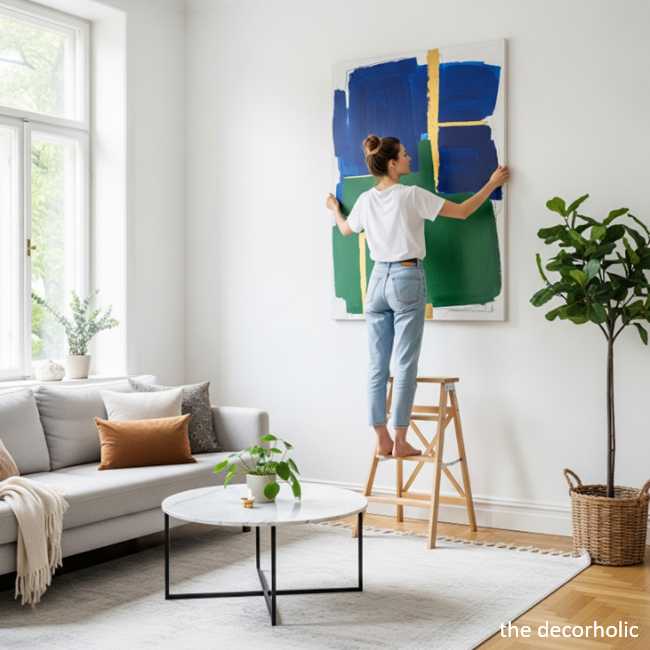
Successfully hanging heavy or valuable decor requires more than just finding studs—proper technique, appropriate hardware, and wall-type awareness determine whether your installations withstand years of use or fail within weeks.
Understanding Wall Load Capacity
Drywall alone supports approximately 10 pounds per square foot when using standard picture hangers—adequate for small frames but woefully insufficient for anything substantial. When you engage a stud, load capacity jumps dramatically to 50-100 pounds per anchor point, depending on screw size and wood quality. This difference explains why professional installers insist on stud mounting for items exceeding basic picture weight.
For decor between 10-20 pounds that falls between studs, specialized drywall anchors like toggle bolts or molly bolts distribute force across larger wall areas. However, these solutions work only in pristine drywall—older walls with previous repairs, plaster construction, or wallpaper application require stud mounting regardless of weight.
Reading Your Walls: Material Matters
Modern construction typically uses 0.5-inch drywall over 16-inch on-center stud spacing. However, your home might feature:
- Plaster walls: Common in pre-1950 homes, typically 0.75-1 inch thick over wooden lath. Requires deep-scanning stud finders and longer screws.
- Tile backerboard: Adds 0.5 inches to bathroom and kitchen walls. Requires masonry bits and careful stud location before drilling through multiple layers.
- Textured surfaces: Heavy texture or wallpaper can cause false readings on basic stud finders. Multi-sensor models penetrate these surface variations more reliably.
Hardware Selection for Different Decor Types
Floating shelves: Require substantial engagement—minimum 2.5-inch screws into studs for shelves supporting books or substantial decor. Hidden bracket systems demand precise stud centering since adjustment isn’t possible post-installation.
Large mirrors and artwork: Use D-ring hangers or wire systems that distribute weight across two stud locations. For pieces exceeding 40 pounds, install cleats across multiple studs rather than relying on single-point hanging.
Gallery walls: Mix stud-mounted heavier pieces with lightweight frames between studs using appropriate anchors. Plan layouts with heavier items at stud locations, filling spaces between with lighter elements.
The Professional’s Scanning Technique
- Start high: Begin scanning near the ceiling where wall cavities are typically empty, establishing baseline readings before moving to cluttered areas.
- Sweep horizontally: Move the stud finder slowly (about one inch per second) across the wall at the height where you’ll mount your item. Mark both edges of each detected stud.
- Verify vertically: Once you’ve marked potential stud locations horizontally, scan vertically along each marked line to confirm the stud runs continuously to your mounting height.
- Triangle technique: When you must mount between studs, scan at three different heights (your mounting point plus 12 inches above and below). This triangulation reveals whether pipes, wires, or blocking might interfere.
- Document your findings: Use painter’s tape or light pencil marks to map your entire wall’s infrastructure before drilling. This reference prevents re-scanning if you adjust your layout mid-project.
Pro Tip: Take photos of your walls with stud locations marked before painting or wallpapering during renovations. These reference images become invaluable months later when you want to hang new decor and can’t see your original markings.
Most Popular Post:
Interior Design Style Quiz
Timeless Paint Colors That Never Go Out of Style
Create Your Perfect Ergonomic Home Office: A Complete Guide
Must-Have Accessories for Guys: The Secret to a Stylish Space
Modular Sofas for Small Spaces: Brilliant Solutions for Compact Living
VI. Conclusion: Why Design-Conscious Homeowners Never Skip This Step
Investing in the best stud finder transforms decorating from a risky gamble into a confident, creative process—protecting your walls, your decor pieces, and your budget while enabling the design freedom you’ve earned in your home.
The difference between homes that feel professionally designed and spaces that scream “DIY disaster” often comes down to invisible details. Crooked shelves, patched drywall from failed installations, or conspicuously asymmetric layouts telegraph amateur execution. Meanwhile, homes where every element hangs perfectly level, securely anchored, and intentionally spaced demonstrate the preparation that produces polished results.
You didn’t invest time curating vintage finds, hunting perfect paint colors, and styling vignettes just to undermine that vision with preventable installation errors. The best stud finder is your insurance policy against the three catastrophes that plague decorating enthusiasts: aesthetic failure when pieces hang crookedly or fall, financial disaster when poor installation damages pipes or wiring, and creative paralysis when fear of wall damage prevents you from executing your design ideas.
For less than the cost of repairing one medium-sized wall damage incident, you gain the tool that enables confident creativity for decades. That floating shelf system you’ve been dreaming about? Achievable. The gallery wall you’ve pinned 47 examples of? Now within reach. The statement mirror that will transform your entryway? No longer too intimidating to attempt.
Stop letting inadequate tools dictate your design possibilities. Choose a stud finder that matches your ambitions, learn proper technique, and transform your house into the carefully curated space you’ve envisioned. Your walls—and your future self standing before perfectly hung artwork—will thank you.
Ready to hang your decor with confidence? Choose your ideal stud finder from our curated list above and transform your next decorating project from nerve-wracking to effortless. Your perfectly styled walls are waiting.
Best Stud Finder-Frequently Asked Questions (FAQ)
Q: Can I use my smartphone as a stud finder instead of buying a dedicated tool?
A: While stud finder apps exist, they rely on your phone’s magnetometer to detect metal fasteners—essentially replicating the most basic magnetic stud finder technology from decades ago. These apps can’t detect wood studs directly, struggle with non-magnetic construction materials, fail to identify pipes or wires, and produce inconsistent results across different phone models. For occasional use with lightweight decor, apps might suffice, but anyone serious about safe, reliable wall mounting should invest in a proper stud finder with multi-sensor technology and safety features.
Q: Why does my stud finder keep giving different readings in the same spot?
A: Inconsistent readings typically stem from three issues. First, your finder may not be calibrated correctly—most models require calibration on a stud-free wall section before each use. Second, wall texture, paint layers, or previous patching can create density variations that confuse electromagnetic sensors. Third, you might be detecting blocking, diagonal bracing, or electrical conduit rather than actual studs. Switch to a multi-sensor model for clearer results, or verify findings by checking at multiple heights—real studs run continuously from floor to ceiling while anomalies typically appear only at specific elevations.
Q: How do I find studs in plaster walls or tile backsplash areas?
A: Plaster and tile challenge basic stud finders because their irregular density creates false readings. For these surfaces, upgrade to deep-scanning models specifically rated for plaster walls (Zircon’s MetalliScanner series or Franklin’s ProSensor MAX). Alternatively, use magnetic stud finders that detect nails and screws directly rather than measuring density changes. In tile areas, mark potential stud locations before tile installation, or use the “outlet location” method—outlets mount to studs, so measuring 16 inches left or right from an outlet box typically locates adjacent studs in standard construction.
Q: What’s the difference between edge-finding and center-finding stud finders?
A: Edge finders alert when they reach a stud’s edge, requiring you to mark both sides and manually calculate the center. Center finders use multiple sensors to identify the stud’s midpoint directly. Multi-sensor models like the Franklin ProSensor series display the entire stud profile at once—showing both edges and center simultaneously. For precise decor mounting, center-finding or multi-sensor models eliminate calculation errors that cause off-center drilling and weak anchor points.
Q: How much weight can I safely hang using studs versus drywall anchors?
A: Properly installed lag screws into studs support 50-100 pounds per anchor point—adequate for floating shelves, large mirrors, and substantial artwork. Drywall alone, even with premium anchors like toggle bolts, maxes out around 20-30 pounds per anchor and degrades over time as drywall compresses. For items exceeding 10 pounds or anything irreplaceable, always use stud mounting. When studs don’t align with your layout, install a horizontal mounting board across multiple studs, then attach your decor to that board—this distributes weight across multiple structural points rather than stressing single anchors.
Subscribe To the Newsletter!
Subscribe now for an endless feed of inspirational women’s cave decor ideas, pampering rituals, and more tips for curating your ultimate escape. Let’s start making your cozy refuge a reality – you so deserve this!
CATCH THE LATEST IN HOME DECOR TRENDS:
Steal These 16 Expert-Approved Decorating Secrets

How To Accessorize Your Living Room
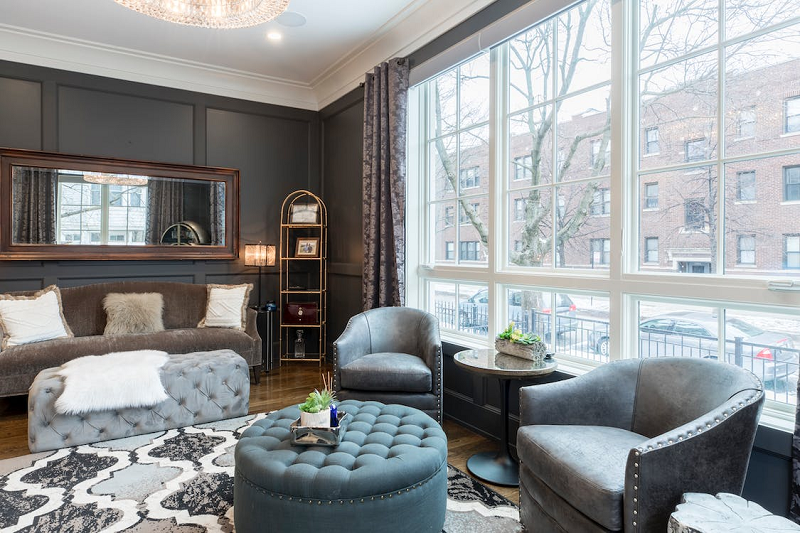
Small Space? 10 Ways To Make A Room Appear Bigger

Make Your space Look Expensive
GET CAUGHT UP ON ALL THE INSPIRING DECOR TIPS:
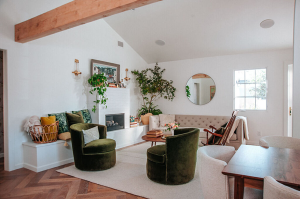
18 Fresh Decorating Ideas To Update Your Fireplace

How To Create An Art Gallery Wall


